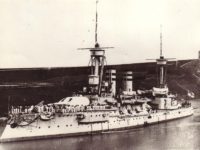After the mass production of standard-line ships was started in England, the German Navy also developed types of ships that met the new requirements and were to replace the obsolete armored ships. This started the construction of the Brandenburg class, which consisted of a total of 4 ships.
Launching and design:
In 1884, Lieutenant General Leo von Caprivi, as Admiralty Chief, presented the Reichstag with a concept for the further development of the German navy. This included the focus on the development and construction of armored ships should form the core of the Navy.
For this purpose, the ships of the Brandenburg classes were developed and started in 1890 with the construction. For the first time, the four ships of the class were equipped with radio, also a nickel steel armor was installed with a thickness of 40cm.
The ships were powered by 12 cylinder boilers with 2 stationary 3-cylinder compound machines that delivered a power of 9,686 hp.
The heavy artillery was now also installed on the midship line to perform a broadside fire with all the guns on both sides. Unlike in the subsequent Kaiser Friedrich class six 28 cm guns were installed in three twin towers in the Brandenburg classes.
The launch of SMS Wörth took place on 6 August 1892.
History of the SMS Wörth:
The commissioning of the Wörth took place on October 31, 1893. When the Boxer Rebellion broke out in China in 1900, the Wörth was sent there with the 2nd Division to knock it down. However, the ship did not participate in combat operations in the area. In August 1901, the division returned to Wilhelmshaven.
In the period of 1902 and 1905, maintenance, reparation and modernization measures were carried out on all four ships of the Brandenburg class. Subsequently, the Wörth was assigned to the II Squadron and then formed the newly established reserve formation of the North Sea. After 1911, the ships were no longer actively used in the Imperial Navy, as they were already considered outdated.
With the outbreak of World War I, the ships were reactivated and assigned to the newly formed 5th Squadron. However, the main task was limited to outpost services. After from February 1915 already staff shortage in the imperial navy emerged, the 5th Squadron was withdrawn from service.
The SMS Wörth was used after the recall of the monitoring service only as a dwelling in Danzig.
The end of SMS Wörth:
After the First World War, the SMS Wörth was deleted from the list of warships on March 10, 1919 and sold to a Dutch company. this had the ship scrapped in 1920.
Ship data:
| Ship type | Ironclad |
| Country | Germany |
| Launching | August 6, 1892 |
| Whereabouts | Scrapped in 1920 |
| Plating | Belt armor: 305 - 406mm
Deck: 60mm Towers: 127mm Control desk: horizontal: 30mm Barbettes: 300mm |
| Drive | 12 transverse cylinder steam boilers with coal firing 2 standing 3-cylinder triple expansion Steam engines with 9,686 hp |
| Length | 113,9 meters |
| Width | 19,5 meters |
| Draft | 7,4 meters |
| Displacement | 10.670 metric tons |
| Speed | 16.3 knots |
| Arming | 6 x shroud cannons in three twin towers 28cm 8 x cannon 10.5 cm 8 x guns 8,8 cm 12 x revolver cannons 3.7 cm 6 x torpedo tubes Ø 45 cm |
| Crew | 568-591 man |
This post is also available in:
 Deutsch (German)
Deutsch (German)  Français (French)
Français (French)  Italiano (Italian)
Italiano (Italian)  简体中文 (Chinese (Simplified))
简体中文 (Chinese (Simplified))  Русский (Russian)
Русский (Russian)  Español (Spanish)
Español (Spanish)  العربية (Arabic)
العربية (Arabic)

















